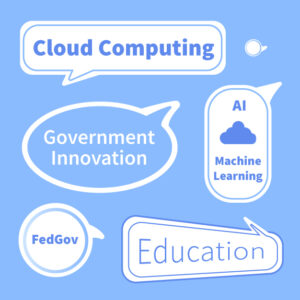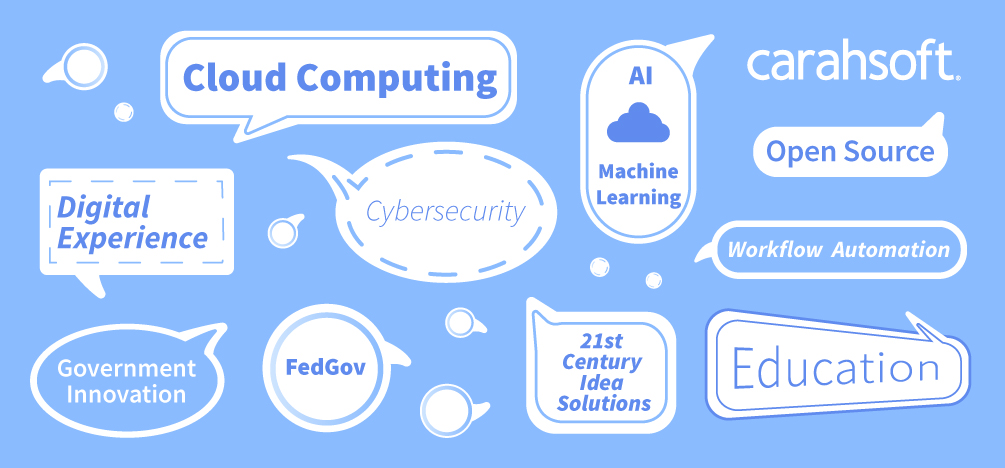2020 was an unprecedented year with certain trends in technology developing practically overnight. IT solutions such as cybersecurity and workflow automation became more important than ever as many across the nation began working from home. During this time, Government agencies have become more adaptable, security-focused, and driven to ensure the digital experience has and continues to be successful. Here’s a look back at our Top 10 Carahsoft Community Blog posts of 2020 featuring this year’s most popular IT topics.
1) IT TRENDS IN GOVERNMENT: The Cloud and Electronic Signatures
Digital experiences are at the center of most services that citizens utilize day-to-day, and throughout government they can impact access to important services, such as healthcare, food aid, and housing. In order to ensure that these services are adequately accessible to the public, proper measures must be taken to make content available across devices, adaptable for use by all users regardless of physical ability, and consistent in appearance.
The best way to achieve digital experiences that adhere to the aforementioned criteria is to utilize the appropriate technology, such as form creation software and electronic signature platforms, which are becoming increasingly prevalent. In this post, Carahsoft’s Senior Product Specialist, Ashley Weston, examines two of Government’s top IT trends to achieving key digital experiences—form creation and e-signatures.
2) How Federal Agencies Can Achieve Section 508 Compliance
Technology has enabled users with visual or other impairments to more easily navigate the world around them, and government organizations are increasingly expected to abide by basic digital accessibility standards and to comply with federal requirements.
One such requirement is aimed at federal agencies, ensuring the government’s digital presence is accessible to users with disabilities. Section 508, which is part of the Rehabilitation Act of 1973, mandates that all electronic and information technology used by the federal government—including websites, social media, job application portals, and more—must be accessible to the 60 million people in the United States living with disabilities. In this post, Addteq partnered with Atlassian to explain how federal agencies can achieve Section 508 compliance.
3) Tips and Tricks to Establishing a Successful Telework Environment
As swaths of organizations in the United States are forced to shutter their workplaces in the wake of the coronavirus pandemic, unprecedented numbers of employees are conducting business as usual—from the safety of their homes. Some states have placed restrictions on nonessential businesses, and many organizations—including government contractors—have taken the initiative to encourage employees to work from home. In this post, Carahsoft’s Adobe Product Specialist discusses tips and tricks to successfully establish a large scale Telework Environment during the beginning stages of the coronavirus pandemic in the Unites States.
4) Evolving Kubernetes into an Enterprise Container Platform
State agencies and academic institutions are increasingly challenged to keep up with the speed of innovation while meeting stakeholder demands and expectations. By turning to container-based services, organizations enable efficient, affordable application delivery and cloud migration. Kubernetes, an open source platform, is the industry standard in container orchestration technology, but managing and running “do it yourself” Kubernetes is easier said than done. In this post, Red Hat experts explain how organizations can use container-based services to enable efficient, affordable application delivery and cloud migration.
5) Start Your Agency Off on the Best Cybersecurity Foot With Federal Frameworks
According to the SolarWinds 2019 Federal Cybersecurity survey report, threats posed by careless and malicious insiders and foreign governments are at an all-time high. The report found 56% of federal government IT leaders surveyed considered careless or untrained insiders as the most significant threat to their organizations. Fifty-two percent said foreign governments are the primary menace to their agencies.
Despite this, federal agencies surveyed believe their ability to detect and prevent insider and malicious external threats has improved over the last year. Agencies attribute this confidence to updated federal regulations and mandates that give them the ability to better manage risk as part of their overall security posture. In this post, we spoke with SolarWinds about how agencies can effectively tailor their cybersecurity frameworks.
 6) 3 Reasons Federal Healthcare Agencies Need Cloud Computing
6) 3 Reasons Federal Healthcare Agencies Need Cloud Computing
It’s been six years since U.S. healthcare providers were required to integrate medical records into electronic systems under the American Recovery and Reinvestment Act. Since then, newer mandates have continued to encourage digital data sharing and interoperability within healthcare organizations.
A natural next step in the digitization of healthcare records is storing that data in the cloud, where it can be securely accessed and updated by healthcare teams. Additionally, when paired with cutting-edge artificial intelligence and machine learning technologies, cloud computing can offer data analysis that facilitates breakthroughs in medical research and patient care. In this post, Google Cloud talks 3 essential reasons that cloud computing can make a change in federal healthcare agencies.
7) How AI is Helping Government Agencies Deliver on their Missions
The Federal Data Strategy’s 2020 Action Plan released in December set the stage for how government agencies should prioritize data in the coming year. Since that time, many agencies have taken aggressive steps to turn their data holdings into strategic assets. One area of focus has been the increased adoption of AI and machine learning technologies. In my role, I work closely with the agencies and their data teams sitting on the front lines of this innovation. The early adopters who began their big data journey over the last few years are starting to see how data and predictive analytics can support their mission goals and create additional value for their stakeholders. In this post, Databricks walked us through examples of this implementation with teams across federal, state, and local agencies.
8) Creating Modern IDEA Compliant Citizen Experiences
Federal agencies are no longer expected to be just sources of information and services. They’re now tasked with providing digital experiences on par with those found on consumer sites. This starts with having a website compliant with the 21st Century Integrated Digital Experience Act (IDEA). It also means incorporating useful content, a personalized experience, and data management that allows non-technical stakeholders to update and maintain the site. In this post, Liferay’s Kale Fluharty dives deep into how to create a government compliant citizen experience using DXP with USWDS 2.0.
9) How Facial Recognition Can Keep Flexible Workplaces Safe
As state and federal agencies begin exploring hybrid workplace models and planning on how to keep employees safe as the COVID pandemic continues to evolve, compliance is a critical piece of the puzzle. Office reopening plans are only as successful as their implementation, and government organizations must be able to ensure that whatever precautions they put into place—from requiring masks and social distancing to keeping remote or revolving workstations secure—are effective. In this post, piXlogic’s Joseph Santucci explains ways that facial recognition can improve workplace safety, especially during a COVID-era in which employee accountability is imperative.
10) Leaders In Innovation: Identity and Access Management
Agencies have been learning the importance of identity and access management for nearly two decades, but, like many technological evolutions, the coronavirus pandemic has encouraged adoption on an entirely new scale. As remote work became the norm, agencies adapted to use technology like smart identity cards in new ways, enabling capabilities like digital signatures. These new features are secured by the common access card (CAC) in the Department of Defense (DoD) or the Personal Identity Verification (PIV) card in the civilian environment, and all follow the principles and strategies of identity and access management. In this post, we summarized the full Leaders in Innovation report which discussed the benefits and challenges of identity and access management.
Though this year presented its challenges, such as many companies moving completely out of office due to a global pandemic, Government Technology has evolved to expand its capabilities. During this struggle, we’d like to thank all of our authors, contributors and readers for their support within our community. We’re pleased to continue growing our blog and expanding our content, and look forward to bringing you even more in 2021.
Thanks for checking out our top 10 Community Blog posts for 2020! Come back soon to read our upcoming series on public sector IT trends that will be mission critical in 2021 – we will be taking a deeper look into: Workflow Automation, Artificial Intelligence and Machine Learning, Cybersecurity and Multicloud Technology.







